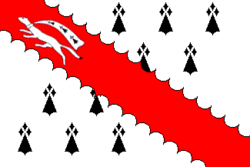Bro Gwened



Gwened, Bro-Gwened (Breton: Bro-Wened) or Vannetais (French: Pays Vannetais) is a historic realm and county of Brittany in France. It is considered part of Lower Brittany.[1]
Bro-Gwened was an early medieval principality or kingdom around
.Today its territories are included within the modern French department of Morbihan.
Name
The
Veneti, the Romans' name for the Gaulish tribe in the area. (It is unrelated to the Welsh realm and county of Gwynedd, which developed from Latin Venedotia.[1]
)
The historic realm was also known as Bro Erec (
gallicisation of the same name) or by numerous variant spellings,[6] although it is unclear whether the namesake Gwereg was Waroch I or II
.
History
The land was allegedly founded by
high kings of Brittany
, with Bro Gwened forming part of their lands.
Dialect

The
2nd person singular pronoun.[10]
Tartan
As a historic Breton county, Bro-Wened is registered as an official tartan with the British government.[12]
See also
- Domnonia(Domnonée)
- Leon (Léon)
- Cornouaille
References
- ^ a b c d e "AM". "Gwened (Vannes/Vannetais)" in Celtic Culture: A Historical Encyclopedia, Vol. I, p. 860. ABC-CLIO (Sta. Barbara), 2006.
- ^ Baring-Gould, pp. 91–92.
- ^ The Bulletin of the Board of Celtic Studies, Vol. XV–XVII, p. 181. University of Wales Press (Cardiff), 1952.
- ^ Via the Old Breton forms Giünet and Günett to later Guened and finally Gwened.[3]
- ^ "JTK". "Civitas" in Celtic Culture, Vol. I, pp. 450–451.
- ^ Including Bro-Uueroc.[5]
- ^ "European Kingdoms Celts of Armorica". 2014. The History Files. Retrieved 13 June 2014.
- ^ a b Baring-Gould, Sabine. The Lives of the Saints, Vol. XVI, "The Celtic Church and its Saints", p. 103. Longmans, Green, & Co. (New York), 1898.
- ^ Ford, David Nash. "King Tewdwr Mawr" at Early British Kingdoms. 2001. Accessed 1 Dec 2014.
- ^ a b c d Kergoat, Lukian. "Breton Dialects" in Celtic Culture, Vol. I, pp. 250 ff.
- ^ Hemon, Roparz (1975). A Historical Morphology and Syntax of Breton. Dublin: Dublin Institute for Advanced Studies. p. 5.
- ^ The Scottish Register of Tartans. "Tartan Details—Bro-Wened Archived December 8, 2014, at the Wayback Machine". National Records of Scotland (Edinburgh), 2014.
